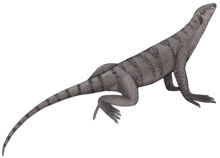| Araeoscelis Temporal range: Artinskian
| |
|---|---|

| |
| Life restoration | |
| Scientific classification | |
| Domain: | Eukaryota |
| Kingdom: | Animalia |
| Phylum: | Chordata |
| Class: | Reptilia |
| Order: | †Araeoscelidia |
| Family: | †Araeoscelidae |
| Genus: | †Araeoscelis Williston 1910 |
| Type species | |
| Araeoscelis gracilis Williston 1910
| |
| Species | |
| |
| Synonyms | |
| |
Araeoscelis (from Greek: αραιά araiá, 'thin' and Greek: σκελίς skelís, 'ribs of beef')[1] is an extinct genus of tetrapods from the Early Permian of what is now Texas. Fossils have been found in the Nocona, Arroyo and Waggoner Ranch Formations. Two species have been described, A. casei and A. gracilis.[2]
Araeoscelis belonged to the clade Araeoscelidia together with close relatives such as Petrolacosaurus. Araeoscelidia is often considered the most basal group of diapsid reptiles, but some analyses have recovered them as stem-amniotes instead.[3][4]
- ^ Colbert, Edwin H. (Edwin Harris); Knight, Charles Robert (1951). The dinosaur book : the ruling reptiles and their relatives. New York : Published for the American Museum of Natural History by McGraw-Hill. p. 145. Retrieved 17 December 2022.
- ^ Dixon, Dougal (2015). The Complete Illustrated Encyclopedia of Dinosaurs. London: Hermes House.
- ^ Simões, Tiago R.; Kammerer, Christian F.; Caldwell, Michael W.; Pierce, Stephanie E. (2022-08-19). "Successive climate crises in the deep past drove the early evolution and radiation of reptiles". Science Advances. 8 (33): eabq1898. Bibcode:2022SciA....8.1898S. doi:10.1126/sciadv.abq1898. ISSN 2375-2548. PMC 9390993. PMID 35984885.
- ^ Klembara, J.; Ruta, M.; Anderson, J.; Mayer, T.; Hain, M.; Valaška, D. (2023). "A review of Coelostegus prothales Carroll and Baird, 1972 from the Upper Carboniferous of the Czech Republic and the interrelationships of basal eureptiles". PLOS ONE. 18 (9): e0291687. Bibcode:2023PLoSO..1891687K. doi:10.1371/journal.pone.0291687. PMC 10513281.